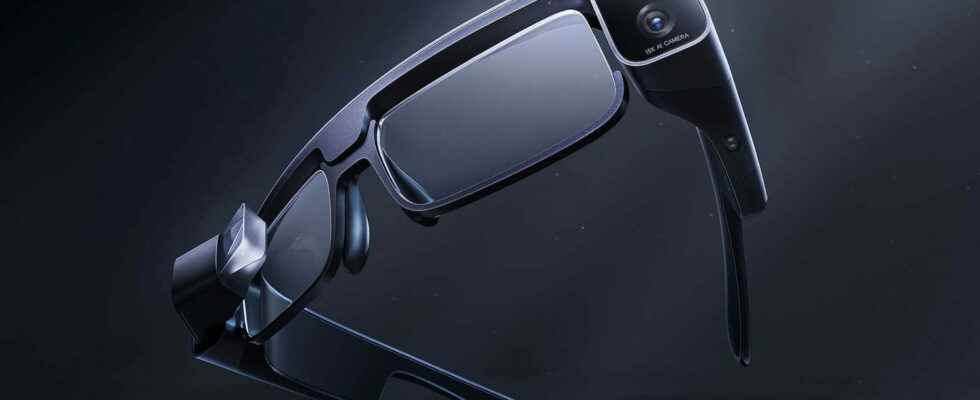Xiaomi has just presented the Mijia Glass Camera, connected glasses for augmented reality. Well equipped, but not very discreet, they promise surprising uses such as real-time text translation.
The augmented reality (AR) sector, and more particularly connected glasses, is booming and digital giants like Google, Apple or Meta have decided to invest massively in it, in order to be the first to revolutionize this technology. . The concept is simple: display via the glasses virtual elements in front of the wearer’s eyes. Some have already taken the risk, such as Oppo with its Air Glass, Google with its Google Glass or even his recent prototypee – although none of the items listed have been sold to the general public. Today is the Chinese manufacturer Xiaomi to present its connected glasses, the Mijia Glasses Camera. As a reminder, the firm had already mentioned its AR glasses in September 2021, but the model which has just been unveiled turns out to be very different from the concept which was proposed last year.
Mijia Glass Camera: quality but bulky equipment
The first thing that jumps out at you – and it has to be said! – is the design of the glasses. The Mijia Glasses Camera will certainly not go unnoticed because, even if they opt for a fairly classic shape, they are still equipped with a bulky device on each side. For discretion, it is missed. However, they remain relatively light since they weigh only 100 grams.
On the right is a Sony MicroLED screen, a technology that is supposed to be even more efficient than Oled. It offers an impressive peak brightness of up to 3,000 nits – better than most PC monitors and TVs! –, with a pixel density of 3,281 ppi (dots per inch), much higher than that of Retina type screens, the pixels being completely indistinguishable. It is this screen that is responsible for displaying augmented reality content, superimposed. On the left, there is a dual photo sensor with a 50-megapixel main sensor and an 8-megapixel periscope telephoto lens with optical stabilization (OIS). It also has a 5x optical or hybrid zoom up to 15x. The interior of the device is not left out since the Mijia Glasses Camera are equipped with a Qualcomm Snapdragon chip with 8 cores, 3 GB of Ram and 32 GB of storage – the equivalent of what we find in a smartphone. And to communicate with the outside, they have Wi-Fi and Bluetooth 5.0 modules.
To power all this paraphernalia, the glasses rely on a 1,020 mAh battery with 10W magnetic charging. They incorporate 10W fast charging technology that recovers 80% battery life in 30 minutes, according to Xiaomi . In all, the Mijia Glasses Camera can shoot continuously for 100 minutes on a single charge. This is important since they are designed for taking photos and recording videos. You can then automatically transfer them to a smartphone via the Mijia application, then apply a filter or share them on social networks.
Of course, and like other devices of the same type – like the Ray-Ban Stories by Meta – the Mijia Glass Cameras are equipped on the front with a small LED that lights up to signal that the wearer is taking pictures. or record videos. A witness who avoids abuse and espionage by informing people around that they can appear on images. It remains to be seen whether this indicator light is sufficiently visible and therefore effective in practice.
Mijia Glass Camera: connected glasses that make everyday life easier
Mijia glasses are not only used to take pretty photos and videos, because their interest would be very limited compared to a smartphone or a GoPro type action camera. Their most amazing feature is real-time translation between English and Chinese – but other languages will no doubt be added later, if the product is successful. Thanks to the cameras, they can instantly translate elements from another language, such as a restaurant menu, posters or road signs, for example. The translation is displayed directly in front of the wearer’s eyes. Google has taken the concept further by also translating audio content, such as a conversation or a TV show.
The Mijias Glasses Camera also have other nice functions, such as the display of GPS instructions in augmented reality on the MicroLED screen – an arrow indicating which street to turn -, intelligent recognition of animals and plants, but also gardening and cooking tips. Updates are planned thereafter to offer new functions.
Mijia Glass Camera: a crowdfunding program in China
The Mijias Glasses Camera will continue their development thanks to a crowdfunding campaign organized by Xiaomi. Thus, they are available for pre-order since August 3 via the Xiaomi Youpin platform, the group’s online store. The program is open to all buyers residing in China. The starting price is set at 2,699 yuan – or around 390 euros – but people pre-ordering the product will have a special price of 2,499 yuan – or around 360 euros. The marketing of the glasses is not planned internationally for the moment and will undoubtedly depend on the first returns.
